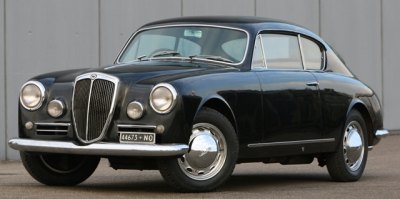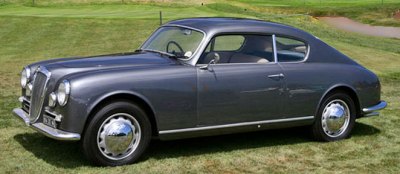 The Aurelia family consists of saloon, coupe (B20) and spider (B24). It was the first post-war Lancia model as well as the first one developed after the death of Vincenzo Lancia. The loss of Vincenzo could be a major blow to the company. Fortunately, his son Gianni hunted famed engineer Vittorio Jano from Alfa Romeo to take over its engineering department. The latter did not disappoint, as Aurelia lived up to the expectation for the high standard of innovation and engineering excellence of Lancia. History book tells us it introduced the world's first ever production V6 engine. It also employed many advanced designs of the time, such as rear-mounted transaxle (for better weight distribution), independent semi-trailing arm rear suspensions (probably the first of its kind) and inboard drum brakes (to reduce unsprung weight). Among all the versions of Aurelia, the most memorable must be the coupe known as B20 GT. Its elegant bodywork was styled by Ghia and built by Pininfarina. Wheelbase was shortened by 200mm from the Belina (saloon). The early coupe was powered by a 2.0-liter version of the V6 with 75 hp output, good for a top speed of 101 mph. It wasn't very powerful, but thanks to its excellent chassis balance, it took second place in the 1951 Mille Miglia race, trailing only a Ferrari 340 America which had more than twice the engine capacity and horsepower.  Though V-shape 8 and 12-cylinder engines had been productionized by American (most notably Cadillac and Packard), contemporary car makers did not produce any V6 engines because this configuration could generate a great deal of vibration. Lancia's engineer Francesco de Virgilio and Ettore Zaccone-Mina found if the V-angle was set at 60 degrees, most of the vibration would be self-cancelled. As a result, they developed a 60-degree V6 with aluminum heads and block, cast-iron liners and OHV push-rod valve actuation. It was not supposed to be a firebreathing powerplant like Ferrari's V12, but it was smooth, compact and feasible for mass production. In the quest of more power, the V6 was enlarged to 2.5 liters in 1953. Output increased to 118hp, lifting performance to nearly the level of Bentley R-type Continental. In the following years, Aurelia coupe was further refined, improving reliability, build quality, roadholding (thanks to a new de Dion axle rear suspension introduced in 1954) and sound insulation, but in the process it also got heavier and slower. Motor historians regarded the early 2.5-liter cars were the best among all series. They combined sportscar performance with quality finishes and engineering excellence very few could match. No wonder they were the road car choice of racing drivers like Juan Manuel Fangio and Mike Hawthorn. |